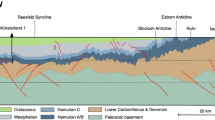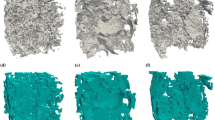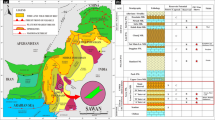Abstract
The identification of pore fluid type, saturation and distribution pattern within the pore space is of great significance as several seismic and petrophysical properties of porous rocks vary largely by fluid type, saturation and fluid distribution pattern. With the help of rock physics modeling, the impact of fluid saturation as well as fluid distribution pattern on seismic velocities, acoustic impedances and seismic amplitudes is estimated on porous rock of early Cretaceous Mississauga sands. For this purpose two saturation patterns: uniform and patchy saturations are considered within the pore spaces. The primary goal of this study is to understand the vertical and horizontal trends of numerous seismic parameters such as P-wave velocity (V P ), S-wave velocity (V S ), their impedances, V P /V S ratio, bulk density (ρ b ), seismic reflectivity etc. as a function of fluid saturation, saturation pattern (patchy or homogeneous), porosity (ϕ) and clay content. The results reveal that the seismic parameters and offset dependent amplitudes are very sensitive to pore fluid saturation and distribution patterns and physical properties. As the hydrocarbons (oil/gas) saturation increases, the compressional wave velocity decreases. P-wave velocity is 20–40 % higher in case of patchy saturation than of homogeneous saturation. Similarly, reservoir porosity and clay matrix control the elastic response of porous rock due to which seismic velocities decrease with increase in porosity and clay content.






Similar content being viewed by others
References
Ahmed N (2013) Rock physics modeling and sensitivity analysis of AVO derived indicators to discriminate fluids and lithologies of Penobscot area, Nova Scotia, Canada. Dissertation, University of the Punjab
Ahmed N, Khalid P, Ghazi S, Anwar AW (2014) AVO forward modeling and attributes analysis for fluid’s identification: a case study. Acta Geod Geophys. doi:10.1007/s40328-014-0097-x
Batzle ML, Wang Z (1992) Seismic properties of pore fluids. Geophysics 57:1396–1408
Berryman JG, Berge PA, Bonner BP (2002) Estimating rock porosity and fluid saturation using only seismic velocities. Geophysics 67:39–404
Dvorkin J, Nur A (1998) Time average equation revisited. Geophysics 63:460–464
Dvorkin J, Moos D, Packwood JL, Nur AM (1999) Identifying patchy saturation from well logs. Geophysics 64:1756–1759
Gassmann F (1951) Uber die Elastizitat poroser Medien. Vierteljahrsschr Natforsch Ges Zür 96:1–23
Hill R (1952) The elastic behavior of a crystalline aggregate. Proc Phys Soc Lond Ser A 65:349–354
Hill R (1963) Elastic properties of reinforced solids: some theoretical principles. J Mech Phys Solids 11:357–372
Khalid P, Ghazi S (2013) Discrimination of fizz water and gas reservoir by AVO analysis: a modified approach. Acta Geod Geophys 48:347–361
Khalid P, Brosta D, Nichita DV, Blanco J (2014a) A modified rock physics model for analysis of seismic signatures of low gas-saturated rocks. Arab J Geosci 7:3281–3295
Khalid P, Ahmed N, Khan KA, Naeem M (2014b) AVO-derived attributes to differentiate reservoir facies from non-reservoirs facies and fluid discrimination in Penobscot area. Geoscience J. doi:10.1007/s12303-014-0048-0
Khan KA, Akhter G, Ahmad Z (2010) OIL—output input language for data connectivity between geoscientific software applications. Comput Geosci 36:687–697. doi:10.1016/j.cageo.2009.09.005
Knight R, Dvorkin J, Nur A (1998) Acoustic signatures of partial saturation. Geophysics 63:132–138
Korneev V, Glubokovskikh S (2013) Seismic velocity changes caused by an overburden stress. Geophysics 78:WC25–WC31
Kuster GT, Toksoz MN (1974) Velocity and attenuation of seismic waves in two-phase media—part I: theoretical formulations. Geophysics 39:587–606
Mavko G, Mukerji T (1998) Bounds on low-frequency seismic velocities in partially saturated rocks. Geophysics 63:918–924
Mavko G, Mukerji T, Dvorkin J (2009) The rock physics handbook. Cambridge University Press, Cambridge
Murphy W, Reischer A, Hsu K (1993) Modulus decomposition of compressional and shear velocities in sand bodies. Geophysics 58:227–239
Reuss A (1929) Berechnung der fliessgrense von mischkristallen auf grund der plastizitatbedingung fur einkristalle. Zeitschrift furAnge-wandte Mathematik aus Mechnik 9:49–58
Sayers CM (2006) An introduction to velocity-based pore-pressure estimation. Lead Edge 25:1496–1500
Tatham RH (1982) V P /V S and lithology. Geophysics 47:336–344
Toms J, Müller TM, Gurevich B (2007) Seismic attenuation in porous rocks with random patchy saturation. Geophys Prospect 55:671–678
Voigt W (1910) Lehrbuch der Kristallphysik. Teubner, Leipzig
Wang Z (2000) The Gassmann equation revisited: comparing laboratory data with Gassmann’s predictions. In: Wang Z, Nur A (eds) Seismic and acoustic velocities in reservoir rocks, 3: recent developments. Soc Expl Geophys, pp. 8–23
Wood AB (1941) A textbook of sound. G. Bell and sons, London
Zhu X, McMechan GA (1990) Direct estimation of the bulk modulus of the frame in fluid saturated elastic medium by biot theory. In: 60th annual international meeting, SEG expanded abstracts, pp 787–790
Zinszner B, Pellerin FM (2007) A geoscientist’s guide to petrophysics. Technip, Paris
Zoeppritz K (1919) Erdbebenwellen VIIIB, on the reflection and propagation of seismic waves. Göttinger Nachrichten 1:66–84
Author information
Authors and Affiliations
Corresponding author
Rights and permissions
About this article
Cite this article
Ahmed, N., Khalid, P. & Anwar, A.W. Rock physics modeling to assess the impact of spatial distribution pattern of pore fluid and clay contents on acoustic signatures of partially-saturated reservoirs. Acta Geod Geophys 51, 1–13 (2016). https://doi.org/10.1007/s40328-015-0101-0
Received:
Accepted:
Published:
Issue Date:
DOI: https://doi.org/10.1007/s40328-015-0101-0




